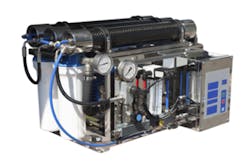When it comes to RO systems, fully functioning, clean membranes are critical for thorough efficiency, prompting the need for end users – homeowners and business owners — to properly maintain and protect them.
By pretreating water before it goes through RO filters, end users can safeguard the membrane while simultaneously sparking a surge in overall performance, extending the operational life of the system and receiving the greatest return on investment.
The purpose of pretreatment
Understanding the water source is a crucial factor for supplying adequate pretreatment to the RO system. "A thorough water analysis will identify contaminants that can severely affect the life of the membranes," says AXEON Water Technologies Vice President of Business Development Henry Avina.
Certain levels of contaminants — an array of organics and inorganics in high quantities, such as sodium chloride (NaCL), iron and hardness (calcium carbonate) — can breach the filters and seep into the membrane, drastically impacting performance and the operational lifespan.
"Organics can pass through a particle filter depending on the size, nature and deformability and quickly cut the flow of a membrane," explains Cris Lemay, regional sales manager for Graver Technologies.
Microbes may get trapped within the filters or on the surface of the membranes, continues Lemay, and sequentially feed off the water’s organic material and cut the filter’s life in cases of rapid growth — typically the product of increased temperatures.
Applying the right pretreatment technique, keeping in mind the type of water passing through the RO system, can help keep operations functioning properly.
The latest in RO maintenance strategies
Maintaining RO systems efficiently requires a reasonable amount of time and preparation in addition to effective execution once a set treatment strategy is established.
Here are a few factors to consider concerning RO systems, suggested by Lemay:
- Determining particle size and concentration aids in selecting suitable microfiltration prior to the membrane.
- Organics might not be picked up in a particle analysis or Silt Density Index test; a broad analysis, such as GC, can be valuable for waters with already installed membranes, varying water sources or known concerns with the water — for example, difficulty cleaning and/or short life.
- There is no set standard on what determines filter ratings; if a high quality or high efficiency filter is used as a prefilter, it reduces the load on the membrane. The cost may be greater, but so will the operative lifecycle.
- "One size fits all" should not be a universal rule regarding pretreatment/prefiltration.
"The vast majority of filters in use in pre-RO applications are melt blown cartridges, which typically have a one inch inner core," Lemay decrees, highlighting that flow rates exceeding 15 to 20 gpm can significantly contribute to pressure drop. Three to five gpm, per 10 inches, with individual filters not exceeding 15 gpm, is an ideal fitting.
Avina adds the following guidelines:
- Feed water temperature can considerably affect RO production; for example, the difference between treating water at 40°F compared to 77°F, will decrease production capability by 37.5 percent.
- The future need of system productivity is often overlooked due to users providing only what they need initially. Systems capable of expansion may raise initial cost, but it will help lower future operational expenses.
- Cleaning membranes regularly can expand the performance of the membrane, but this should not be a substitute to pretreatment.
In addition to these recommendations and observations, advancements for RO pretreatment are being developed and employed. "Membrane manufacturers now offer a specialty line of membranes that have a charged coating applied to the surface of the membrane," says Avina. "Chemical anti-scalants are also fast becoming the first line of defense against membrane fouling. Pricing has now reached a level where the use of chemical anti-scalants are an economical solution."


